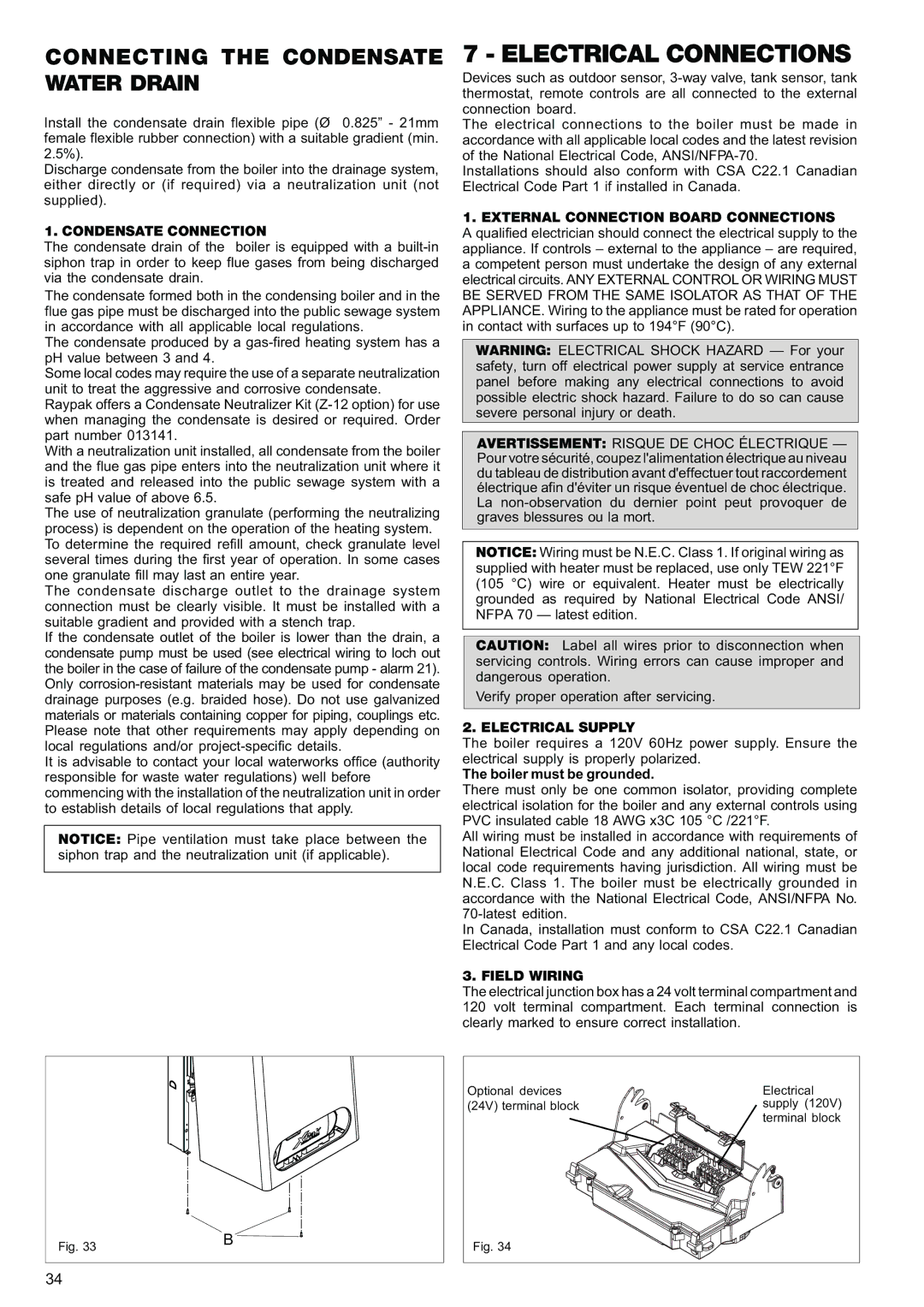CONNECTING THE CONDENSATE WATER DRAIN
Install the condensate drain flexible pipe (Ø 0.825” - 21mm female flexible rubber connection) with a suitable gradient (min. 2.5%).
Discharge condensate from the boiler into the drainage system, either directly or (if required) via a neutralization unit (not supplied).
1. CONDENSATE CONNECTION
The condensate drain of the boiler is equipped with a built-in siphon trap in order to keep flue gases from being discharged via the condensate drain.
The condensate formed both in the condensing boiler and in the flue gas pipe must be discharged into the public sewage system in accordance with all applicable local regulations.
The condensate produced by a gas-fired heating system has a pH value between 3 and 4.
Some local codes may require the use of a separate neutralization unit to treat the aggressive and corrosive condensate.
Raypak offers a Condensate Neutralizer Kit (Z-12 option) for use when managing the condensate is desired or required. Order part number 013141.
With a neutralization unit installed, all condensate from the boiler and the flue gas pipe enters into the neutralization unit where it is treated and released into the public sewage system with a safe pH value of above 6.5.
The use of neutralization granulate (performing the neutralizing process) is dependent on the operation of the heating system. To determine the required refill amount, check granulate level several times during the first year of operation. In some cases one granulate fill may last an entire year.
The condensate discharge outlet to the drainage system connection must be clearly visible. It must be installed with a suitable gradient and provided with a stench trap.
If the condensate outlet of the boiler is lower than the drain, a condensate pump must be used (see electrical wiring to loch out the boiler in the case of failure of the condensate pump - alarm 21). Only corrosion-resistant materials may be used for condensate drainage purposes (e.g. braided hose). Do not use galvanized materials or materials containing copper for piping, couplings etc. Please note that other requirements may apply depending on local regulations and/or project-specific details.
It is advisable to contact your local waterworks office (authority responsible for waste water regulations) well before commencing with the installation of the neutralization unit in order to establish details of local regulations that apply.
NOTICE: Pipe ventilation must take place between the siphon trap and the neutralization unit (if applicable).
7 - ELECTRICAL CONNECTIONS
Devices such as outdoor sensor, 3-way valve, tank sensor, tank thermostat, remote controls are all connected to the external connection board.
The electrical connections to the boiler must be made in accordance with all applicable local codes and the latest revision of the National Electrical Code, ANSI/NFPA-70.
Installations should also conform with CSA C22.1 Canadian Electrical Code Part 1 if installed in Canada.
1. EXTERNAL CONNECTION BOARD CONNECTIONS
A qualified electrician should connect the electrical supply to the appliance. If controls – external to the appliance – are required, a competent person must undertake the design of any external electrical circuits. ANY EXTERNAL CONTROL OR WIRING MUST BE SERVED FROM THE SAME ISOLATOR AS THAT OF THE APPLIANCE. Wiring to the appliance must be rated for operation in contact with surfaces up to 194°F (90°C).
WARNING: ELECTRICAL SHOCK HAZARD — For your safety, turn off electrical power supply at service entrance panel before making any electrical connections to avoid possible electric shock hazard. Failure to do so can cause severe personal injury or death.
AVERTISSEMENT: RISQUE DE CHOC ÉLECTRIQUE — Pour votre sécurité, coupez l'alimentation électrique au niveau du tableau de distribution avant d'effectuer tout raccordement électrique afin d'éviter un risque éventuel de choc électrique. La non-observation du dernier point peut provoquer de graves blessures ou la mort.
NOTICE: Wiring must be N.E.C. Class 1. If original wiring as supplied with heater must be replaced, use only TEW 221°F (105 °C) wire or equivalent. Heater must be electrically grounded as required by National Electrical Code ANSI/ NFPA 70 — latest edition.
CAUTION: Label all wires prior to disconnection when servicing controls. Wiring errors can cause improper and dangerous operation.
Verify proper operation after servicing.
2. ELECTRICAL SUPPLY
The boiler requires a 120V 60Hz power supply. Ensure the electrical supply is properly polarized.
The boiler must be grounded.
There must only be one common isolator, providing complete electrical isolation for the boiler and any external controls using PVC insulated cable 18 AWG x3C 105 °C /221°F.
All wiring must be installed in accordance with requirements of National Electrical Code and any additional national, state, or local code requirements having jurisdiction. All wiring must be N.E.C. Class 1. The boiler must be electrically grounded in accordance with the National Electrical Code, ANSI/NFPA No. 70-latest edition.
In Canada, installation must conform to CSA C22.1 Canadian Electrical Code Part 1 and any local codes.
3. FIELD WIRING
The electrical junction box has a 24 volt terminal compartment and 120 volt terminal compartment. Each terminal connection is clearly marked to ensure correct installation.

